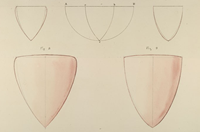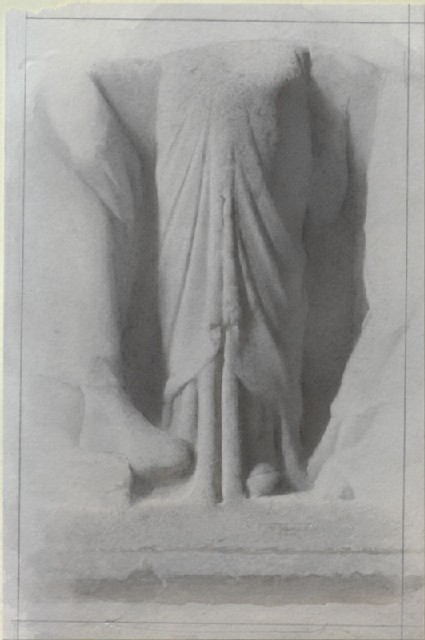Ruskin's Rudimentary series, 5th ed. (1873)
Items marked 'M' are drawings "by my own Hand" (by Ruskin), P are photographs, E engravings and A by Ruskin's Assistant, Arthur Burgess.

Ruskin's Catalogues: 1 object
Show search help- Reference URL
Actions
Study of Part of the Sepulchral Relief of Demetrius Alexander Macdonald
-
Ruskin text
R|57} Study of Greek sculpture, full size of the original in the University galleries. A. Macdonald. -
Details
- Artist/maker
-
Alexander Macdonald (1847 - 1921)
- Object type
- drawing
- Material and technique
- graphite and grey wash on paper
- Dimensions
- 255 x 170 mm
- Inscription
- Verso, in graphite:
top left: R/57
just below and to the right, written diagonally up the sheet: Macdonald
bottom right, the Ruskin School's stamp
- Provenance
-
Presented by John Ruskin to the Ruskin Drawing School (University of Oxford), 1875; transferred from the Ruskin Drawing School to the Ashmolean Museum, c.1949.
- No. of items
- 1
- Accession no.
- WA.RS.RUD.057
-
Subject terms allocated by curators:
Subjects
-
References in which this object is cited include:
References
Ruskin, John, The Ruskin Art Collection at Oxford: Catalogue of the Rudimentary Series, in the Arrangement of 1873, ed. Robert Hewison (London: Lion and Unicorn Press, 1984), cat. Rudimentary no. 57, RUD.057
Ruskin, John, Instructions in Practice of Elementary Drawing, Arranged with Reference to the First Series of Examples in the Drawings Schools of the University of Oxford (n.p., [1872]), cat. Rudimentary no. 57
Ruskin, John, Instructions in the Preliminary Exercises Arranged for the Lower Drawing-School (London: Smith, Elder, 1872), cat. Rudimentary no. 57
Ruskin, John, Instructions in the Preliminary Exercise Arranged For the Lower Drawing-School (London: Spottiswoode, 1873), cat. Rudimentary no. 57
Ruskin, John, ‘Rudimentary Series 1878’, 1878, Oxford, Oxford University Archives, cat. Rudimentary no. 57
Ruskin, John, ‘The Ruskin Art Collection at Oxford: Catalogues, Notes and Instructions’, Edward T. Cook and Alexander Wedderburn, eds, The Works of John Ruskin: Library Edition, 39 (London: George Allen, 1903-1912), 21, cat. Rudimentary no. 57
Location
-
- Western Art Print Room
Position in Ruskin’s Collection
Ruskin's Catalogues
-
Ruskin's Rudimentary series, 3rd ed. (1872)
R|57} Study of Greek sculpture, full size of the original in the University galleries. A. Macdonald. -
Ruskin's Rudimentary series 4th ed. (1872)
R|57} Study of Greek sculpture, full size of the original in the University galleries. A. Macdonald. -
Ruskin's Rudimentary series, 5th ed. (1873)
R|57} Study of Greek sculpture, full size of the original in the University galleries. A. Macdonald. -
Ruskin's revision to the Rudimentary series (1878)
remains 57.Standard for execution of shade in drawings admitting its full depth. Held upside down it will be seen that the folds of the drapery might represent two beautiful leaves of a water-plant clasping its ascending stem. This shows at once the strictly ornamental and constructive arrangements, not only of every line, but of every surface in noble sculpture. In archaic Greek and Etruscan sculpture and in the parallel Christian schools of the xiith century these ornamental lines are disposed under the strictest submission to the law of gravity; the substance of the stuff being conceived as entirely fluent and incapable of forming an angle, unless under such violent tension as that of a whiplash when it is cracked. The introduction of draperies capable of sustaining themselves in angles is a sign of later schools, and the prevalence of such drapery of debased ones.





